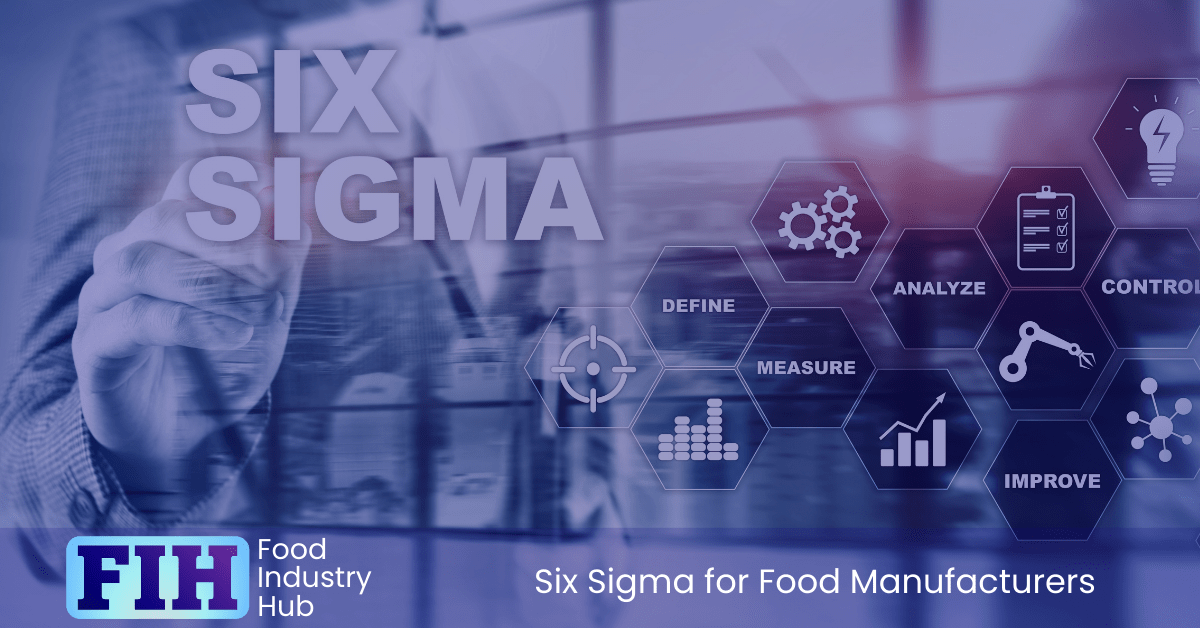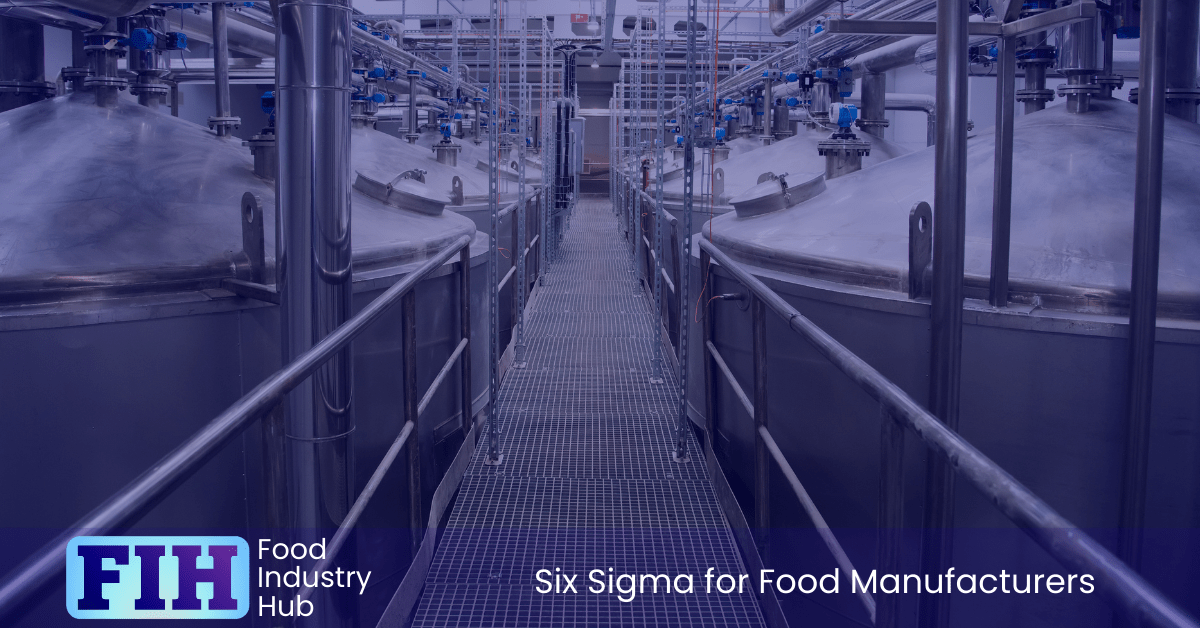Introduction
As a food manufacturer, you’re likely always on the hunt for ways to enhance your production processes. Have you ever considered the Six Sigma methodology? This technique, focused on reducing defects and increasing efficiency, could drastically transform your operations. By defining, measuring, analysing, improving, and controlling your processes, you might just find that waste decreases while customer satisfaction skyrockets. But it’s not just about the immediate changes – think about the long-term impact on your business’ competitiveness and reputation. Intrigued? Let’s explore this further.
Table of Contents
Key Takeaways
- Six Sigma in food manufacturing focuses on reducing defects and variability to improve product quality and customer satisfaction.
- It emphasises data-driven decision making, process improvement, and employee involvement for effective problem-solving.
- The DMAIC methodology of Six Sigma identifies, measures, analyses, improves, and controls process improvements to ensure sustainable gains.
- Six Sigma fosters continuous improvement in food manufacturing through small, incremental changes that improve efficiency, quality, and safety.
- Various Six Sigma roles, including Yellow Belt, Green Belt, and Black Belt, contribute uniquely to the process improvement strategy in food manufacturing.

Transform your food manufacturing processes with Food Industry Hub Management Systems, designed for audit-readiness and compliance every day.
Introduction to Six Sigma
The concept of Six Sigma might seem intimidating at first, but it’s actually a straightforward approach to quality management. This method, pioneered by Motorola in the 1980s, is all about eliminating defects and reducing variability in business processes.
As a food manufacturer, you’re constantly striving for consistency and quality in your products. Six Sigma can help you achieve this. It’s a statistical-based approach that focuses on improving and stabilising operations. It’s not just about solving problems, but preventing them from happening in the first place.
To put it simply, Six Sigma measures how far a process deviates from perfection. The ultimate goal? Achieve near perfect results – only 3.4 defects per million opportunities. That’s what the ‘six’ in Six Sigma represents – six standard deviations between the process mean and the nearest specification limit.
Six Sigma’s power lies in its customer-centric approach. It prioritises what the customer considers important, and it’s this focus on customer satisfaction that can set your business apart.

Principles of Six Sigma
Let’s now get into the principles of Six Sigma, which are key to its application in food manufacturing.
You’ll see that it’s grounded in customer focus, data-driven decision making, process improvement, involvement of people, and continuous improvement.
Understanding these foundations will enable you to effectively apply Six Sigma in your operations.
Customer Focus
In Six Sigma, you’re not just producing food. You’re creating an experience for your customers. Every ingredient, every process, and every final product should meet their needs and exceed their expectations. This is the essence of a customer-focused approach.
But how does it work? It’s all about understanding your customers. You need to know who they are, what they want, and how they perceive your products. Once you’ve gathered this information, you can tailor your food production to their needs.
It’s not just about making food that tastes good. It’s about making food that your customers want to buy, time and time again.
In the food manufacturing industry, this can make all the difference. A customer-focused approach can help you stand out from competitors, increase customer loyalty, and boost your bottom line.
So, take the time to listen to your customers. Find out what they’re looking for in a food product. Then, use this information to guide your production processes.
Data-Driven Decision Making
Building on a customer-focused approach, you also need to understand the importance of data in Six Sigma. Six Sigma’s methodology isn’t guesswork. Instead, it’s a data-driven approach that provides you with a clear understanding of your manufacturing process.
You’re not just making decisions based on instincts or past experiences. You’re making decisions based on hard data. That’s the power of Six Sigma. It’s the ability to look at the numbers, analyse them, and then make informed decisions that can improve your food manufacturing process.
When you use data to drive your decisions, you’re reducing the chance of making a mistake. You’re also increasing the likelihood of making a decision that’s going to benefit your company.
Think of it this way. If you’re guessing, you could be right, or you could be wrong. But if you’re using data to guide your decisions, you’re basing your actions on facts, not assumptions. This increases your chance of success.
Process Improvement
Understanding the principles of Six Sigma can revolutionise your approach to process improvement.
It’s all about identifying and eliminating the causes of defects and variation in your manufacturing processes. You’re not just making changes for the sake of it, you’re implementing meaningful, data-driven improvements.
Six Sigma uses statistical tools to help you understand where and why errors occur. This isn’t about guesswork; it’s a methodical, evidence-based approach.
You’ll measure and analyse your processes, identify the root causes of problems, and then implement solutions. You’re not just putting a band-aid on the problem; you’re finding a cure.
The beauty of Six Sigma lies in its iterative nature. You’ll continuously improve your processes, making them more efficient and reducing waste along the way.
It’s a never-ending cycle of enhancement that’ll keep you ahead of the competition.
Involvement of People
Nearly everyone involved in your manufacturing process plays a crucial role in Six Sigma’s success. From your product developers to your packaging staff, each person’s involvement is critical.
You see, Six Sigma isn’t just about systems or processes. It’s about people, too.
Your team’s understanding of Six Sigma principles, their commitment to its application, and their willingness to adopt its methodologies will determine how effective the Six Sigma approach can be in your food manufacturing operation.
But how do you ensure this?
Firstly, you’ve got to invest in training. Make sure your employees understand what Six Sigma is, why it’s important, and how it can help them in their jobs.
Encourage them to ask questions, to challenge the status quo, and to propose innovative solutions.
Secondly, foster a culture of involvement. Make your team feel valued, heard, and integral to the Six Sigma process.
Reward innovative ideas and encourage teamwork.
Because, at the end of the day, it’s not just about improving processes. It’s about empowering your people to drive those improvements, making your business better, and your customers happier.
Continuous Improvement
With your team fully engaged in the Six Sigma process, it’s time to focus on the concept of Continuous Improvement, a cornerstone of Six Sigma principles.
This principle isn’t about making huge, sweeping changes all at once. It’s about making small, incremental improvements over time that add up to significant gains.
Continuous Improvement is about fostering a culture where everyone on the team is actively looking for ways to improve. Each person should be asking, “How can we do this better?”
It’s about challenging the status quo and not being content with ‘good enough.’
In the food manufacturing industry, this could mean seeking ways to improve the efficiency of your production line, enhancing the quality of your products, reducing waste, or improving safety standards.
You’re not just reacting to problems as they arise, you’re proactively seeking out potential issues and addressing them before they become a problem.

The DMAIC Methodology
Now, let’s turn our attention to the DMAIC methodology, a key element of Six Sigma.
You’ll find it’s an acronym for Define, Measure, Analyse, Improve, and Control.
Define
Before diving into the world of Six Sigma, it’s crucial to understand the first step of the DMAIC methodology: Define. This step isn’t about jumping headlong into problem-solving. Instead, it’s about taking the time to clearly identify and outline your project’s purpose, goals, and scope.
You’ll start by defining the problem you’re trying to solve. Maybe it’s a high rate of product defects or an inefficient production process. Whatever it is, you need to describe it in clear, measurable terms. This is where you’ll also identify your project’s stakeholders – those who’ll be affected by the project’s outcome or who’ve a stake in its success.
Next, you’ll establish the project’s objectives. What’re you hoping to achieve? Maybe it’s reducing defect rates by 15% or increasing production efficiency by 20%. Again, these should be clear, measurable goals.
Lastly, you’ll define your project’s scope. This involves setting boundaries for what the project will and won’t cover. It’s crucial to set these boundaries to ensure your project remains manageable and focused.
Measure
After setting your project’s roadmap in the Define stage, you’re ready to move on to the next step of the DMAIC methodology: Measure. This stage is all about collecting data. As a food manufacturer, you’re seeking to quantify the current state of your processes. This could be anything from how long it takes to package your product to the amount of waste produced daily.
Remember, you can’t manage what you can’t measure. So, precise, reliable data is key. You’ll need to develop a detailed measurement system. This includes identifying what needs to be measured, how it will be measured, and who’ll do the measuring.
Consider using tools like record sheets, histograms, or process flow diagrams to visualise your data. These can help you understand the baseline performance and identify any potential issues.
Be thorough and meticulous. If you rush this stage or gather incorrect or incomplete data, you’re setting yourself up for failure in the later stages.
Analyse
Having gathered and measured your data, it’s time to dive deep into the Analyse stage of the DMAIC methodology. This stage is all about understanding the cause-and-effect relationships in your food manufacturing process. It’s not just about looking at the numbers, it’s about understanding what those numbers mean.
Start by identifying potential sources of variation in your process. Maybe it’s an ingredient that’s not always the same quality. Or perhaps it’s a piece of equipment that doesn’t always perform consistently. Once you’ve identified these sources, you can start to investigate their impact.
Use statistical analysis tools like regression analysis or hypothesis testing to determine whether these sources of variation are statistically significant. Don’t be intimidated by these terms. They’re just ways of making sense of your data.
But remember, it’s not enough to just identify the problems. You’ve got to understand why they’re happening. This is where root cause analysis comes in. By digging deep, you’ll uncover the underlying issues that are causing variability in your process.
This stage is all about asking questions and finding answers. It’s about developing a deep understanding of your process so you can improve it. But we’ll discuss that in the next stage.
Improve
Now that you’ve identified and thoroughly analysed the sources of variation in your food manufacturing process, it’s time to make some improvements. This stage, ‘Improve’ in the DMAIC methodology, is where you’ll start seeing tangible benefits.
Start by brainstorming potential solutions to the problems you’ve identified. Lean on your team’s creativity, expertise, and experience. Remember, you’re not just looking for a quick fix, you’re aiming for long-term, sustainable improvements.
Next, you’ll want to test these potential solutions. You can use Design of Experiments (DoE) to determine the most effective solution without having to try each one individually. DoE will help you understand interaction effects and find the optimal settings for your process variables.
Once you’ve found a solution that works, implement it on a small scale first. This pilot phase allows you to iron out any kinks before you roll it out across the whole operation.
Control
Once you’ve successfully implemented improvements, it’s important to maintain them. This brings us to the final phase of the DMAIC methodology: Control. This phase aims to ensure that the improvements you’ve made are sustained over time.
You’ll need to monitor your processes closely to make sure they’re still functioning as expected. Use statistical process control methods to track your progress and identify any deviations from the target. If there are deviations, it’s essential to correct them quickly to avoid falling back into old habits.
Remember, maintaining control isn’t a one-time thing. It’s a continuous process of monitoring, adjusting, and refining your systems. Make sure you’ve got a solid control plan in place, and everyone on the team understands it.
In food manufacturing, maintaining control can mean the difference between success and failure. It’s about ensuring the consistency of your products, meeting safety standards, and satisfying your customers.

Sign-up for the Food Industry Hub Mail Service
We regularly produce new content for food industry professionals, and the Food Industry Hub Mail Service is the best way to stay up to date with the latest additions.
Signup today to be added to the Food Industry Hub mailing list.
Six Sigma Roles
In Six Sigma, you’ll encounter various roles like Yellow Belt, Green Belt, Black Belt, Master Black Belt, and Champion.
Each of these roles has a unique set of responsibilities and functions within the Six Sigma framework.
Let’s explore what each of these roles does and how they contribute to the overall process improvement strategy.
Yellow Belt
You might be wondering, what exactly does a Yellow Belt in Six Sigma do? As a Yellow Belt, you’re the backbone of any Six Sigma project. Your role involves supporting project teams by participating in problem-solving tasks and assisting Green Belts and Black Belts when needed.
You’ll have a basic understanding of Six Sigma’s principles, allowing you to contribute positively to your organisation’s continuous improvement efforts. You’ll be expected to master the fundamental elements of the Define-Measure-Analyse-Improve-Control (DMAIC) methodology, which provides a structured approach for problem-solving.
In the food manufacturing industry, this could involve identifying potential improvements in production processes or quality control, while maintaining compliance with food safety regulations.
You might also help collect and analyse data to understand current process performance, identify root causes of issues, and implement solutions.
Green Belt
Moving up the Six Sigma hierarchy, we find the Green Belt role. As a Green Belt, you play a crucial part in the Six Sigma team. Your tasks include analysing and solving quality problems. You’re also empowered to participate in quality improvement projects.
Your role as a Green Belt doesn’t stop at problem-solving. You also act as a liaison or bridge between the Six Sigma team and the rest of the organisation. It’s your job to ensure that Six Sigma methodologies are understood and practiced throughout your company.
In the food manufacturing industry, a Green Belt’s responsibilities can cover a broad range. For example, you might be tasked with reducing waste in the production process, improving packaging quality, or enhancing food safety measures.
Remember, every improvement you make directly affects your company’s profitability and reputation.
To excel as a Green Belt, you’ll need a solid understanding of Six Sigma principles and tools. Training and certification are typically required.
And while you won’t be expected to lead projects – that’s the Black Belt’s role – you’re an essential part of the team, driving the nuts and bolts of quality improvement.
Black Belt
Stepping up from the Green Belt, you’ll find yourself at the Black Belt level of Six Sigma. This role is crucial in food manufacturing as you’re tasked with leading more complex projects, implementing strategic changes, and coaching Green Belts.
As a Black Belt, you’re a problem solver. You’ll tackle issues that could compromise the efficiency and quality of food production. You’ll employ the DMAIC (Define, Measure, Analyse, Improve, Control) methodology and lean principles to identify and eliminate waste and variability in processes.
You’ll also communicate and coordinate with all levels of the organisation. You’ll have to explain technical terms and complex processes in an understandable way, bridging the gap between top management and the production floor.
Your leadership skills will be put to the test as you drive teams towards continuous improvement.
Master Black Belt
Progressing from the Black Belt role, your journey in Six Sigma could lead you to the esteemed rank of Master Black Belt. This role isn’t just a step up—it’s a leap. You’re no longer just managing projects, you’re overseeing multiple initiatives and shaping the organisation’s Six Sigma strategy.
Master Black Belts are responsible for implementing the company-wide Six Sigma strategy, ensuring it aligns with business objectives. They guide and mentor Black Belts and Green Belts, instilling them with the confidence and knowledge to drive improvements in their respective areas.
They’re the embodiment of Six Sigma principles, with a deep understanding of methodologies and statistical tools that far surpasses that of other belts.
But this role isn’t for everyone. It requires strategic thinking, exceptional leadership skills, and a passion for continuous improvement. You’ll need to be a problem solver, a change agent, and a coach.
You’ll also need extensive experience and training in Six Sigma methodologies. However, the rewards are significant. As a Master Black Belt, you’ll be instrumental in driving your company’s success and standing out as a leader in the food manufacturing industry.
Champion
After conquering the challenges of the Master Black Belt role, it’s time to take on the mantle of a Champion in the Six Sigma hierarchy. Your role here isn’t just about mastering statistical tools or leading project teams. As a Champion, you’re more like the project sponsor, responsible for choosing, prioritising, and tracking Six Sigma projects.
What’s expected of you? Simply put, you’re the driving force behind the success of the Six Sigma initiative. You must spearhead the implementation of Six Sigma throughout the organisation, ensuring its principles are ingrained in every process, from manufacturing to quality control.
You’ll need to have a keen understanding of the organisation’s strategy and objectives. This will help you identify the right projects that contribute to these goals.
You’ll also need to rally support from different teams, ensuring they understand and align with the Six Sigma approach.

Benefits of Six Sigma
Now, let’s shift gears and consider the advantages of implementing Six Sigma in your food manufacturing process.
Think about the potential for cost reduction, quality improvement, and increased efficiency.
Also, consider how it can boost employee engagement and significantly lower defect rates.
Cost Reduction
Reducing costs is one of the main benefits of implementing Six Sigma in food manufacturing. When you apply Six Sigma methods, you’re not just ensuring product quality. You’re also fine-tuning your processes, reducing waste, and eliminating unnecessary expenses.
Imagine you’re running a production line. Even a tiny variation in a process can lead to waste. That’s where Six Sigma comes in. It helps identify these variations and correct them. By doing so, you’re not just improving product quality, but also cutting down on waste and saving money.
Think about it. Less waste means fewer raw materials and less energy used. It also translates to less rework, fewer returns, and less time spent on fixing errors. All these savings add up, helping you reduce costs significantly.
But it’s not just about short-term savings. Six Sigma’s focus on continuous improvement means you’re always looking for ways to be more efficient. Over time, these small improvements can lead to substantial cost reductions.
Quality Improvement
Quality improvement is another major advantage of applying Six Sigma in your food manufacturing operations. By adopting this methodology, you’re not just striving for efficiency but also for perfection in every process. You’re making a commitment to continuously improve and deliver the best quality products to consumers.
Six Sigma’s meticulous approach, involving data analysis and statistical tools, helps you identify the root causes of quality issues. You’ll be able to pinpoint the exact process that’s causing defects or inconsistencies. And, once you’ve identified the problem, you can take the necessary steps to eliminate it. That’s how you ensure the quality of your food products consistently meets or exceeds customer expectations.
Six Sigma doesn’t stop at just fixing the problem. It encourages a culture of continuous improvement where you’re always looking for ways to improve quality. Whether it’s a minor tweak in a process or a major overhaul of a system, any improvement that enhances quality is welcomed and promoted.
In essence, Six Sigma provides you with a structured way to improve your product’s quality. It’s not just a benefit; it’s a competitive advantage that sets you apart in the industry.
Increased Efficiency
In the same vein as improving quality, Six Sigma also significantly boosts efficiency in your food manufacturing operations. It’s all about cutting waste and streamlining processes. By identifying and eliminating unnecessary steps in your production line, you’re able to make more with less.
Imagine you’re baking a cake. Six Sigma is like having a recipe that tells you exactly how many eggs to use, the precise temperature to set the oven, and the exact time to bake. It’s the difference between eyeballing measurements and having precise instructions. The result? A perfect cake every time, baked more quickly and with fewer wasted ingredients.
In the context of your food manufacturing business, Six Sigma methodologies reduce production time, minimise waste, and optimise use of resources. The result? A leaner, more profitable operation.
Six Sigma’s data-driven approach ensures that every change you make is based on solid evidence, not just gut feelings. You’re not just hoping for the best, you’re practically guaranteeing it.
This isn’t just about short-term gains. By committing to Six Sigma, you’re setting your business up for long-term success. Efficiency isn’t just an end goal, it’s a continual process of improvement.
And Six Sigma gives you the tools to keep getting better.
Employee Engagement
Embracing Six Sigma doesn’t just revamp your processes, it also energises your team. When you adopt this approach, you’re not just improving efficiency, you’re also fostering a culture of continuous improvement. Your employees become more engaged, as they’re integral to identifying issues and generating solutions.
With Six Sigma, your employees’ roles aren’t restricted to their job descriptions. They’re empowered to contribute to the bigger picture, which boosts morale and motivation. They’re part of a team that’s striving for excellence, which gives them a sense of purpose and achievement.
Investing in Six Sigma training for your staff also demonstrates your commitment to their professional development. They acquire new skills and expand their knowledge base, making them more versatile and valuable to your organisation. This not only enhances job satisfaction but also aids in talent retention.
Six Sigma creates a collaborative environment where everyone’s ideas are valued. This drives innovation and fosters a positive work climate. The result? A more committed, creative, and productive workforce.
In a nutshell, Six Sigma doesn’t just benefit your bottom line, it also enriches your greatest asset – your people. So, it’s a win-win investment for your business.
Defect Reduction
Think about slashing your defect rates by up to 50%. Sounds amazing, doesn’t it? It’s not just a dream. With Six Sigma, it’s a very achievable reality. This quality management strategy provides a systematic approach to identifying and eliminating defects through process improvement.
Six Sigma’s methodology focuses on reducing variability in your processes. This reduction leads to fewer defects, meaning your production becomes more consistent and reliable. You won’t just see a decrease in waste, you’ll also see an increase in customer satisfaction. When you’re delivering top quality products consistently, customers will take notice.
But it’s not only about reducing defects. Six Sigma also provides a clear understanding of what’s causing the defects in the first place. By identifying the root cause, you can make strategic changes to avoid repeating the same mistakes.
This proactive approach saves you time and resources in the long run.

Challenges and Criticisms
While Six Sigma can offer substantial benefits, it’s not without its drawbacks.
You may find the initial implementation costs high and the methodology rigid in its approach.
There’s also the risk of an overemphasis on metrics, which could potentially overshadow other important aspects of your food manufacturing processes.
Implementation Costs
Implementing Six Sigma in your food manufacturing business isn’t a walk in the park. It comes with a hefty price tag. After all, you can’t expect major quality improvements without some significant investment. The costs can quickly add up from training staff, purchasing new equipment, and hiring consultants.
Training is one of the biggest expenditures. You’ll need to train your team on Six Sigma methodologies and tools. This could mean sending them to seminars or in-house training programs. Either way, it’s a substantial expense.
Moreover, you might’ve to hire full-time Six Sigma experts, known as Black Belts or Green Belts. Their salaries can significantly inflate your operational costs.
New equipment purchases may also be necessary. Upgrading your machinery to optimise process efficiency isn’t cheap.
Then, there are the consultants. Many organisations hire them to guide the implementation process. Their fees, coupled with the cost of potential disruptions during the transition period, can be another major expense.
Rigidity
Despite all its benefits, Six Sigma isn’t without its drawbacks in the food manufacturing industry. One criticism is its rigidity. Although its structured approach aids in achieving consistency and reducing variability, it can also hamper innovation and flexibility.
You see, the food manufacturing industry is dynamic. Consumer trends and preferences change rapidly, and manufacturers must adapt quickly to stay competitive. But Six Sigma’s stringent protocols and procedures can make it difficult for you to make swift changes in your manufacturing processes.
You’re required to go through several stages of problem identification, data collection, analysis, improvement, and control. This can be time-consuming and may not allow for quick, creative solutions that are often necessary in this fast-paced industry.
Overemphasis on Metrics
Ever thought about the potential pitfalls of focusing too much on metrics? It’s quite a paradox, you’d think. After all, Six Sigma is about using data to improve processes.
But here’s the catch: while metrics are crucial, overemphasis can lead to issues. You see, overreliance on metrics can skew your perspective. You might end up focusing so heavily on numbers that you forget about other important aspects like employee morale, creativity, and product quality.
You might even overlook the human element, that essential ingredient in any successful business.
What’s more, obsessing over metrics can create a culture of fear. Employees might start worrying more about hitting numbers than about doing a good job. They might even manipulate data to meet targets. That’s hardly the environment you want, right?

In Summary
You’ve seen how Six Sigma can revolutionise your food manufacturing processes. By applying the DMAIC methodology and fostering collaboration, you’re setting the stage for near-perfect quality and reduced waste. Sure, there may be challenges, but the benefits far outweigh them. So, don’t hesitate. Embrace Six Sigma and get ready to outshine your competition. After all, it’s all about continuous improvement and customer satisfaction.
Further Resources
Food Industry Hub serves the food industry with a range of digital resources for the benefit of both commercial food manufacturers and food industry professionals.
For food manufacturers, we offer integrated management systems that give every user a direct interface with your QMS.
For food industry professionals, we provide an extensive signposting service in addition to informational content we hope you’ll find useful as you face new professional challenges. We have very ambitious plans to expand the range of services offered, and currently present informational content on management, safety and quality, food safety and quality culture, and professional success.














